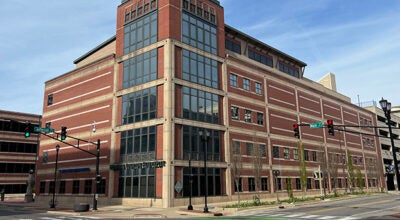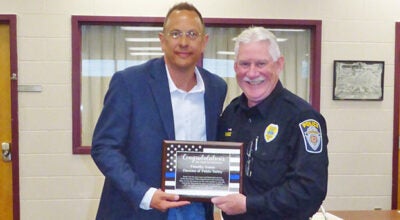French name continues
Published 4:17 pm Friday, August 7, 2009
Part of a continuing series on Niles’ historic Silverbrook Cemetery, provided by Friends of Silverbrook Cemetery, a group working to preserve and restore the cemetery. This is part two of the French family.

Today French Paper Mill is still a family business that has been expanded by J. E. French (center), who is the fourth generation and an employee of French Paper for 68 years; Jerry French (left) fifth generation and an employee for 31 years; and Brian French (right) the sixth generation who has been with the company for one year. Together they represent 100 years of combined experience in the company that J.W. French began in the latter part of the 19th century. (Daily Star photo/Provided)
Historians agree that the Industrial Revolution was one of the most important events in history.
The height of the industrial revolution in Niles, in 1905, saw J. Edward, son of J.W. French assume the helm of the family business.
According to the online historical timeline of the company located at http://frenchsampleroom.typepad.com/: “The second 25 years saw a new name, new President and the new hydro-electric plant on the banks of the St. Joe. The Industrial Revolution was in full swing as was French Paper.”
In 1915, the concrete dam and flumes were built and by 1917, the third generation of the French family in the person of Frank G. French began working at the mill to learn the business from the ground up.
On May 6, 1908, the Niles Daily Star reported that “the French mills are busy despite business depression … the plant and yards occupy 60 acres, employ 225 hands, produce 300 tons of board and paper per week and use 400 cords of wood per week.”
Jerry French, the company’s current president provides this update:
“Today about 75 people are employed at French Paper and we produce approximately the same amount of paper with one less paper machine. A lot has changed since 1907 and I can only imagine how many people it took to move 400 cords of wood each week.
“The average wage in 1907 was close to .32 cents per hour and today it averages over $17.00 per hour plus generous benefits.
“Today, we produce all of our paper with the renewable resource of hydropower. We have used the water to generate electricity to run the plant since approximately 1922. We also are one of the largest recyclers in our area. Last year, we recycled in excess of 23 million pounds of wastepaper.”
In 1921, a new office building was erected and 10 years later Frank G. French became president of the company following the death of his father J. Edward.
It is said that Frank G. was a “born salesman.” When he became president in 1931, he changed the focus of the French line to fine writing, printing and text papers and was the epitome of the company’s reputation for friendly customer service.
The theme of survival continued; in spite of the Great Depression which began a worldwide economic downturn starting in most places in 1929; when unlike most Niles businesses the paper mill stayed open throughout the period, keeping its workers “out of soup lines and trouble.”
Today, recession is everyone’s concern.
“The economy has impacted all of us. Our segment of the paper industry has witnessed a significant reduction of more than 37 percent the past three years. In fact more than 110 paper machines have been shut down in the past 10 years. French Paper feels fortunate that sales have only reduced slightly. We believe that our employees today are quality conscious and that may be part of the reason that we have faired better than many of our competitors,” the current president said.
Indeed by 1936, promotional brochures invited people to “Nest in Niles and live more abundantly.”
In 1945, the company’s world famous “French linen” paper was a major seller. It’s “Parchtone” line was introduced in 1949 as the “first ever printable imitation parchment paper.”
Frank ran the company until his death July 9, 1960 and was in turn succeeded by his son, Joseph “Big Ed” French as the fourth generation to head the company.
Long before the environmental movement became popular, according to company’s timeline history, Big Ed always bragged about how the water that came out of the mill was cleaner than when it went in. To prove his point, he would drink a glass of the exiting water each day.
In keeping with this environmental vision, the company produced “Speckletone” one of the first high-quality recycled papers on the market and the first that incorporated intentional specks and flecks within the bond of the paper.
At the time of a March 25, 1961 article on French Paper Co., it was said that the company “now employs 150 persons, produces 65 tons a day of the highest grade machine finish and super calendared book, lithograph and label papers, bond, writing papers and specialties.”
In 1960, Bruce Bigford, the only non-family member to ever sit in the president’s chair, joined the company. He became president in 1977 and remained in the position until current president Jerry French, Big Ed’s son, took hold of the reins in 1994.
In 1970 the term “paperless society” was coined. Seeing as the Niles based paper mill doubled its business between 1970 and 1995, they would be forgiven if they doubted the prediction.
In an article at http://ecowriter.greenoptions.com/2008/07/20, writer Troy Wolverton is quoted as saying, “For all the wonders of electronic documents, paper still retains some advantages, analysts note. Particularly for older people, paper is much easier to read than a computer monitor. Many people find it easier to digest longer documents in printed form, rather than on a screen. And paper is a lot more portable than a mobile device.”
While the younger generation, addicted to word bites using Twitter and text messaging using their I-Phones, may dispute the latter point, many of us still love the feel of holding a book, prefer the paper edition of this newspaper and long to receive a handwritten letter amongst the bills and junk mail and if that letter is written on the fine French linen paper, all the better.
Have no doubt. The French family has embraced the new technology as an adjunct to running the family business. Their website is chuck full of a wide array of products from the traditional (and not so traditional) papers to décor-a-boards ready-to-hang art made out of birch veneer over MDF board using recycled wood scraps and unused portions of lumbered trees. There is gift wrap, memo books, dinnerware, note cards and even soap.
The sixth generation, Brian French, now has taken over a project known as the Run-Of-The-Mill Club. The website urges consumers to “help Brian make his great-great-great-grandparents proud. Send him your samples printed on French Paper. He’ll send you a box of promotional goodies free.”
Moving even further into the 21st century the company has a substantial Facebook following as well. Check it out at http://www.facebook.com/pages/French-Paper-Company where you can sign up to follow the next chapter of their story.
We can only imagine that J.W. French would be in awe of how all his family has continued to do with the project he began in Niles so many years ago. Then again, considering the vision of the man Orville Coolidge classed as among the “captains of industry in Michigan, his labors being an important factor in making this state a great productive center,” maybe he wouldn’t be so surprised after all and would just smile in pride at it all.
Many of those who rest in Silverbrook have played an undeniable part in both our city’s history and its present.
Want to take part in preserving local history? For more on Friends of Silverbrook with regards to membership and work days to help restore and catalog the monuments contact: Friends of Silverbrook Cemetery c/o 508 E. Main St. Niles MI 49120, Tim and Candace Skalla, 684-2455, wskalla@sbcglobal.net or Ginny Tyler at 445-0997, SPHINX1974@aol.com.






